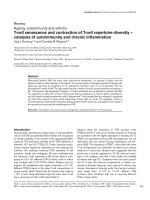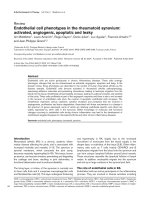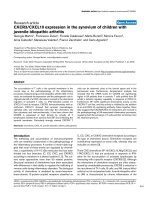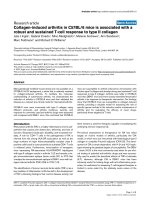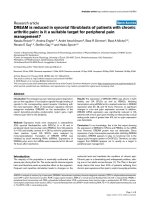Báo cáo y học: " T cell activity in successful treatment of chronic urticaria with omalizumab" pdf
Bạn đang xem bản rút gọn của tài liệu. Xem và tải ngay bản đầy đủ của tài liệu tại đây (218.95 KB, 3 trang )
COM M E N TAR Y Open Access
T cell activity in successful treatment of chronic
urticaria with omalizumab
Inmaculada Sánchez-Machín
1
, Javier Iglesias-Souto
1
, Andrés Franco
2
, Yvelise Barrios
2
, Ruperto Gonzalez
1
and
Víctor Matheu
1,3,4,5,6*
Abstract
Omalizumab, a humanized monoclonal anti-IgE antibody has the potential to alter allergen processing. Recently, it
has been postulated the assessment of PHA-stimulated adenosine triphosphate (ATP) activity as maker of CD4+ T
cells activity in peripheral blood cells. We present the case report of a 35-year-old woman with a history of chronic
idiopathic urticaria and angioedema of 8 years of development with poor response to treatment. The patient was
partially controlled with cyclosporine at doses of 100 mg/12 h. However, she was still developing hives daily.
Finally treatment with omalizumab was started at dose of 300 mg every 2 weeks. The patient experienced a
decrease in urticarial lesions 2 days after starting therapy. We also evaluated the effects of omalizumab therapy on
the activity of peripheral blood CD4+ T cells from the patient, in order to determine the potential modification of
anti-IgE therapy on the process of antigen presentation-recognition. Activity of CD4+ cells by ATP release was
clearly increased demonstrating an enlarged CD4 activity. Omalizumab may be useful in the treatment of severe
chronic urticaria. ATP activity of peripheral blood CD4+ T cells might be a non-subjective method to assess
Omalizumab activity.
We have read the interesting manuscript recently pub-
lished in Clinical and Molecular Allergy entitled “Down
regulation of the high-affinity IgE receptor associated
with successful treatment of chronic idiopathic urticaria
with omalizumab” [1]. The study demonstrated the
effectiveness of omalizumab in treating chronic idio-
pathic urticaria and the temporal relationship between
improvement and d own regulation of the high affinity
IgE receptor (FcεRI). Omalizumab is a recombinant
humanized monoclonal antibody that blocks free-serum
immunoglobulin E (IgE) through the high-affinity Fc
receptor from attaching to mast cells and prevents IgE-
mediated inflammatory changes [2]. The FDA approved
only specific indications for omalizumab use including
patients older than 12 years with moderate-persistent to
severe-persistent asthma with a positive skin test or in
vitro reaction to a perennial ae roallergen and be symp-
tomatic with inhaled corticosteroids.
However, anti-IgE appears to provide a therapeutic
option for cases of many allergic diseases and conditions
in which IgE plays a significant role. Although, the
potential use of omalizumab in other IgE-mediated con-
ditions is being investigated [3,4] and trials in allergic
rhinitis are running, omalizumab is currently been eval-
uated for treatin g food allergy including peanut allergy,
latex allergy, atopic dermatitis, and chronic urticaria
[3,5,6].
Wewouldliketopresenta35-year-oldwomanwith
findings of rhinoconjunctivitis and episodic asthma by
mite sensitization from childhood, severe chronic urti-
caria and angioedema since November 1999 with nor-
mal initial study conducted in 2000 (biochemistry,
haemotology, serology and microbiology analysis). Poor
control was obtained with conventional treatments
(antihistamines and oral corticosteroids). Subsequently,
the patient consulted several speciali sts (dermato logists)
without success and was re-evaluated by Allergology
during hospitalization caused by severe urticaria angioe-
dema exacerbation coinciden t with an epis ode of retinal
detachment. In previous years the urticaria and angioe-
dema had not changed and she still had symptom s
daily. Only in 2004 during pregnancy and subsequent
breastfeeding showed a slight improvement in their
symptoms.
* Correspondence:
1
Alergología, Hospital del Tórax (Ofra); Complejo Hospitalario Universitario NS
Candelaria, S/C Tenerife, Spain
Full list of author information is available at the end of the article
Sánchez-Machín et al. Clinical and Molecular Allergy 2011, 9:11
/>CMA
© 2011 Sánchez-Machín et al; licensee BioMed Central Ltd. This is an Open Access article distribu ted under the terms of the Creative
Commons Attributio n License (http://c reativecommons.org/licenses/by/2.0), which permits unrestricted us e, distribution, and
reproduction in any medium, provided the original work is properly cited.
A new study was done with normality of all the tests,
including complement proteins study again. Then, we
tried different treatments with antihistaminics, doxepin
and corticosteroids. In April 2005, we began cyclospor-
ine at doses of 200 mg per day with good response initi-
ally. Despite of oral contraception method the patient
had a spontaneous miscarriage in that year. During the
next 4 years the minimal doses of cyclosporine were of
100 mg pe r day and the last 2 years with daily cutaneus
lesions. The pacient had exacerbations after walking,
exposure to cold, premenstrual phase and the laboral
absenteeism were important. Due to the poor control
obtained previously, we decided to initiate Omalizumab
therapy in 2008 with 300 mg every 2 weeks, based on
weight and IgE level (178.0 UI/ml). Dramatic relief was
obtained within 72 hours. The patient discontinued by
own decision all medication with no exacerbation. Two
weeks later, she had not injuries and did n ot take a ny
medication. We began to gradually increase the intervals
between doses. Currently we give 300 mg every 6 weeks
and the patient remains asympto matic without any side
effects.Further,wetriedtoextenditto8weeks,but
resulting with small hives in patient’s extremities.
In parallel, whole blood was obtained before each
administration for 18 weeks. Peripheral blood mononuc-
lear cells (PBMC) were obtained and used in fresh for an
immune cell function assay to detect T cell activation
(ImmunoKnow™, Cylex Inc. Columbia, MD). Briefly,
PBMC were incubate d 18-h either in the absence of sti-
mulant to assess basal activity or wi th specific stimulant
for T cells (phytohemagglutinin-PHA). Magnetic beads
coated with mouse monoclonal anti-human CD4 (Dyna-
beads
®
CD4, Dynal Biotech A.S.A., Oslo, Norway) were
added to immunoselect CD4 cells from both the stimu-
lated and non-stimulated cells. After washing the selected
CD4 cells on a magnet tray, a hypotonic basic solution as
lysis reagent was added to release intracellular ATP. Dur-
ing incubation, increased ATP synthesis occurs within
the cells that respond to PHA. The ATP result was mea-
sured by luminescence (562 nm). Serum obtained was
stored and total IgE (UniCAP
®
, Phadia, Uppsala, Sweden)
of every sample were determined in the same immunoas-
say with no significant differences among samples. How-
ever, T cell activat ion was significantly increased from
basal (365 ng/ml ATP-moderate response) to first point,
2 weeks after first injection (593 ng/ml-strong response).
That activation was maintained during following 18
weeks (F igure 1).
The mechanism of action of omalizumab, an anti-IgE
monoclonal antibody, in urticaria [7] is unknown, but in
asthma act inducing the downregulation of IgE receptors
[8,1]. Moreover, omalizumab produces a down regulation
of IgE-mediated basophil activity [9,10] and a
modification of the functional characteristics of dendritic
cells [8]. CD4+T cells have a pivotal role in the process
of antigen recognition in the adaptative inmune response.
Recently, it has been postulated the assessment of PHA-
stimulated adenosine triphosphate (ATP) activity as
maker of CD4+T cells activity in peripheral blood cells
[11]. We evaluated the effects of omalizumab therapy and
observed the successful response to low doses of omalizu-
mab in recalcitrant chronic urticaria and follow up using
peripheral blood CD4+ showing an increase in activity by
measure ment of ATP release. ATP activity of peripheral
blood CD4+T cells might be a non-subjective method to
assess omalizumab ac tivity [12], since the lack of other
objective laboratory test. Further observations are needed.
Acknowledgements
Declaration of sources of funding: Inmaculada Sanchez-Machín has a grant
from Fundación SEAIC (Sociedad Española de Alergologia e Inmunologia
Clinica) 2009. Víctor Matheu is recipient of a grant from “Convenio Instituto
de Salud Carlos III- Comunidad Autónoma de Canarias (Programa de
Intensificación de la Actividad Investigadores Clínicos 2011).
Author details
1
Alergología, Hospital del Tórax (Ofra); Complejo Hospitalario Universitario NS
Candelaria, S/C Tenerife, Spain.
2
Immunology Section, Central Lab, Hospital
Universitario de Canarias, La Laguna, Spain.
3
Department of Clinical Sciences-
Division IV, Lund University, Lund, Sweden.
4
Research Unit; Complejo
Hospitalario Universitario NS Candelaria, S/C Tenerife, Spain.
5
Research Unit,
Hospital Universitario NS Candelaria, Ctra. Rosario 145, S/C Tenerife, 38010
Spain.
6
Department of Clinical Sciences, Division IV, Lund University, Lund
22185 Sweden.
Authors’ contributions
ISM & JIS studied the case report and wrote the initial draft of the
manuscript. AF & YB performed every single lab assay. for in vivo tests. RG
was responsible for the Drug Allergy Section and for safety of administration
with Omalizumab. VM & YB conceived the idea and are responsible of the
final version of the manuscript. All authors approved the final version of the
manuscript.
Competing interests
The authors declare that they have no competing interests.
Received: 1 April 2011 Accepted: 26 July 2011 Published: 26 July 2011
Figure 1 Serial Follow up of T cell activity.SerialFollowupofT
cell activity measured as ATP activity release from T-cell during 18
weeks; patient (red line); control (green line).
Sánchez-Machín et al. Clinical and Molecular Allergy 2011, 9:11
/>Page 2 of 3
References
1. Saavedra MC, Sur S: Down regulation of the high-affinity IgE receptor
associated with successful treatment of chronic idiopathic urticaria with
omalizumab. Clin Mol Allergy 2011, 9(1):2
2. Spector SL, Tan RA: Effect of omalizumab on patients with chronic
urticaria. Ann Allergy Asthma Immunol 2007, 99(2):190-193.
3. Metz M, Bergmann P, Zuberbier T, Maurer M: Successful treatment of
cholinergic urticaria with anti-immunoglobulin E therapy. Allergy 2008,
63(2):247-249.
4. Matheu V, Franco A, Perez E, Hernandez M, Barrios Y: Omalizumab for drug
allergy. J Allergy Clin Immunol 2007, 120(6):1471-1472, author reply 1472-1473.
5. Magerl M, Staubach P, Altrichter S, Ardelean E, Krause K, Metz M, Weller K,
Maurer M: Effective treatment of therapy-resistant chronic spontaneous
urticaria with omalizumab. J Allergy Clin Immunol 2010, 126(3):665-666.
6. Vestergaard C, Deleuran M: Two cases of severe refractory chronic
idiopathic urticaria treated with omalizumab. Acta Derm Venereol 2010,
90(4):443-444.
7. Iemoli E, Piconi S, Fusi A, Borgonovo L, Borelli M, Trabattoni D:
Immunological effects of omalizumab in chronic urticaria: a case report.
J Investig Allergol Clin Immunol 2010, 20(3):252-254.
8. Prussin C, Griffith DT, Boesel KM, Lin H, Foster B, Casale TB: Omalizumab
treatment downregulates dendritic cell FcepsilonRI expression. J Allergy
Clin Immunol 2003, 112(6):1147-1154.
9. Kaplan AP, Joseph K, Maykut RJ, Geba GP, Zeldin RK: Treatment of chronic
autoimmune urticaria with omalizumab. J Allergy Clin Immunol 2008,
122(3):569-573.
10. Noga O, Hanf G, Kunkel G, Kleine-Tebbe J: Basophil histamine release
decreases during omalizumab therapy in allergic asthmatics. Int Arch
Allergy Immunol 2008, 146(1):66-70.
11. Manga K, Serban G, Schwartz J, Slotky R, Patel N, Fan J, Bai X, Chari A,
Savage D, Suciu-Foca N, et al: Increased adenosine triphosphate
production by peripheral blood CD4+ cells in patients with hematologic
malignancies treated with stem cell mobilization agents. Hum Immunol
2010, 71(7):652-658.
12. Matheu V, Perez E, Gonzalez R, Franco A, García-Robaina J, Barrios Y: T cell
activation after Omalizumab for insulin allergy. J Allergy Clin Immunol
2008, 121(2, pt1):s38.
doi:10.1186/1476-7961-9-11
Cite this article as: Sánchez-Machín et al.: T cell activity in successful
treatment of chronic urticaria with omalizumab. Clinical and Molecular
Allergy 2011 9:11.
Submit your next manuscript to BioMed Central
and take full advantage of:
• Convenient online submission
• Thorough peer review
• No space constraints or color figure charges
• Immediate publication on acceptance
• Inclusion in PubMed, CAS, Scopus and Google Scholar
• Research which is freely available for redistribution
Submit your manuscript at
www.biomedcentral.com/submit
Sánchez-Machín et al. Clinical and Molecular Allergy 2011, 9:11
/>Page 3 of 3




